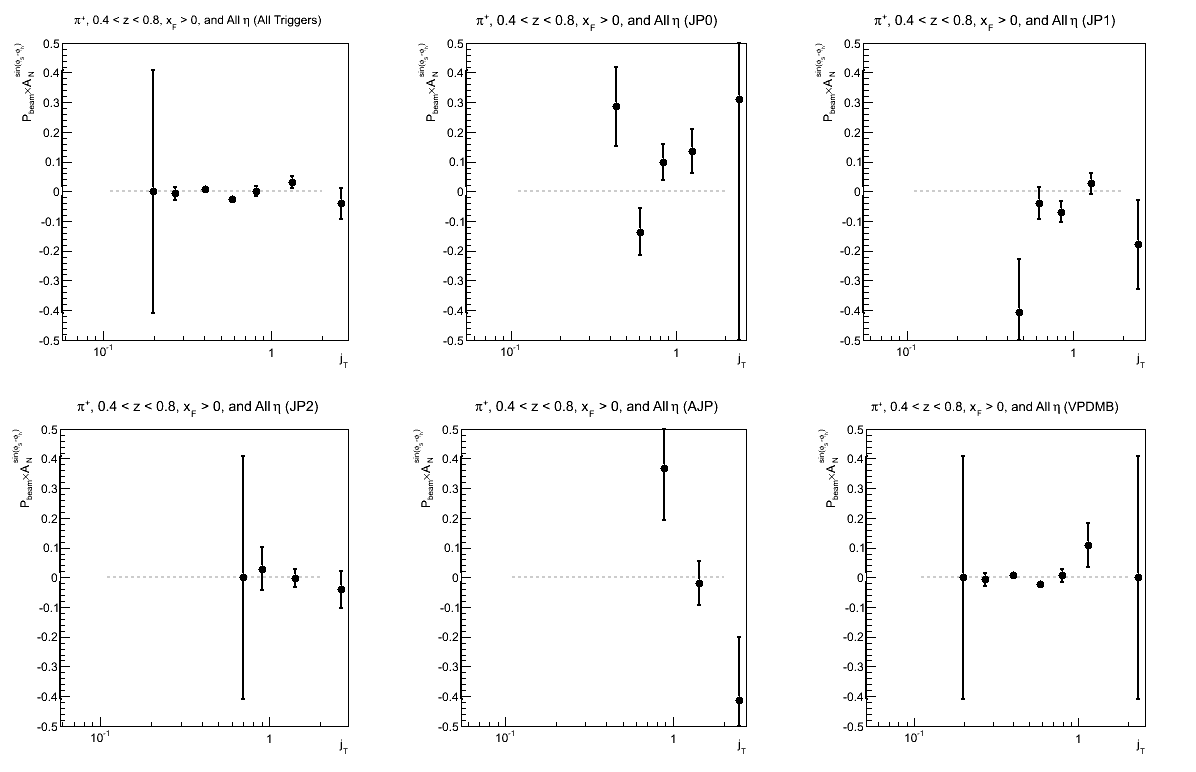- drach09's home page
- Posts
- 2022
- 2020
- June (1)
- 2019
- 2018
- 2017
- 2016
- 2015
- 2014
- December (13)
- November (2)
- October (5)
- September (2)
- August (8)
- July (9)
- June (7)
- May (5)
- April (4)
- March (4)
- February (1)
- January (2)
- 2013
- December (2)
- November (8)
- October (5)
- September (12)
- August (5)
- July (2)
- June (3)
- May (4)
- April (8)
- March (10)
- February (9)
- January (11)
- 2012
- 2011
- October (1)
- My blog
- Post new blog entry
- All blogs
Run-11 Transverse Jets: Update to Jet Group
I have begun to look at transverse-spin jet asymmetries from the Run-11 500 GeV dataset. In this update I look at the Sivers asymmetry in bins of ηjet, Collins asymmetries as a function of z and jT, and the Collins-like asymmetries for which we may have sensitivity. These data reflect about 1/3 of the full dataset. I currently don't have disc space for more jet trees than this. The analysis, here, utilizes the cross-ratio formalism as used in my Run-8 two-particle asymmetry analysis and the on-going Run-6 Collins analysis by Renee, Kevin, and Rob. I also look at some statistical cross-checks of my analysis. The cuts are described in earlier blog posts, and I will summarize them, here. Note that all asymmetries are shown prior to polarization correction.
Cuts and Kinematics
This update focuses on the 12-point branch running the anti-kT algorithm with a radius of 0.6 and minimum pT = 5 GeV/c. Tracks are required to satisfy a hit ratio of 0.51, pT-dependent DCA, and 0.2 < pT < 200 GeV/c. Towers have an ET cut of 0.2 GeV.
I have restricted myself to the following triggers: JP0, JP1, JP2*L2JetHigh, AJP, and VPDMB. VPDMB should provide an interesting data-driven check of trigger bias for JP0. I have required the jet match to a valid trigger patch except in the case of VPDMB, where I simply require the VPDMB trigger fired.
In addition to the trigger-patch matching, I also implement the following definitions:
- VPDMB
- VPDMB trigger fired and pT, jet > 5.0 GeV
- JP0
- JP0 trigger fired and pT, jet > 7.1 GeV
- JP1
- JP1 trigger fired, JP0 trigger did not fire, and pT, jet > 9.9 GeV
- JP2
- JP2 trigger fired, JP1 trigger did not fire, JP0 trigger did not fire, and pT, jet > 16.3 GeV
- AJP
- AJP trigger fired, JP2 trigger did not fire, JP1 trigger did not fire, JP0 trigger did not fire, and pT, jet > 16.3 GeV
I have not restricted myself to a fiducial volume in η. This may be necessary in the future, however, there is some expectation that the analyzing powers increase with increasing η. Therefore, I would like to consider looking at jets as far forward as possible, given detector realities.
For the Collins asymmetries I have tried to restrict myself to pions utilizing the same -1 < nσ(π) < 2 range as the Run-6 Preliminary result. Note, I do not restrict myself to pions for the Sivers asymmetries. I simply look at the jets regardless of the hadrons inside.
Figure 1
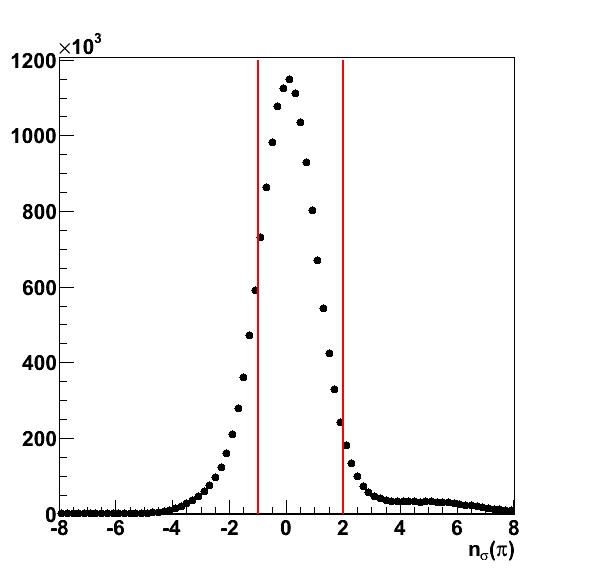
There is also TOF information available; however, at this point, I have not attempted to use it. For the full run, this may be advantageous. To ensure that φh is well-determined, I have implemented a cut of ΔR > 0.1.
Figure 2

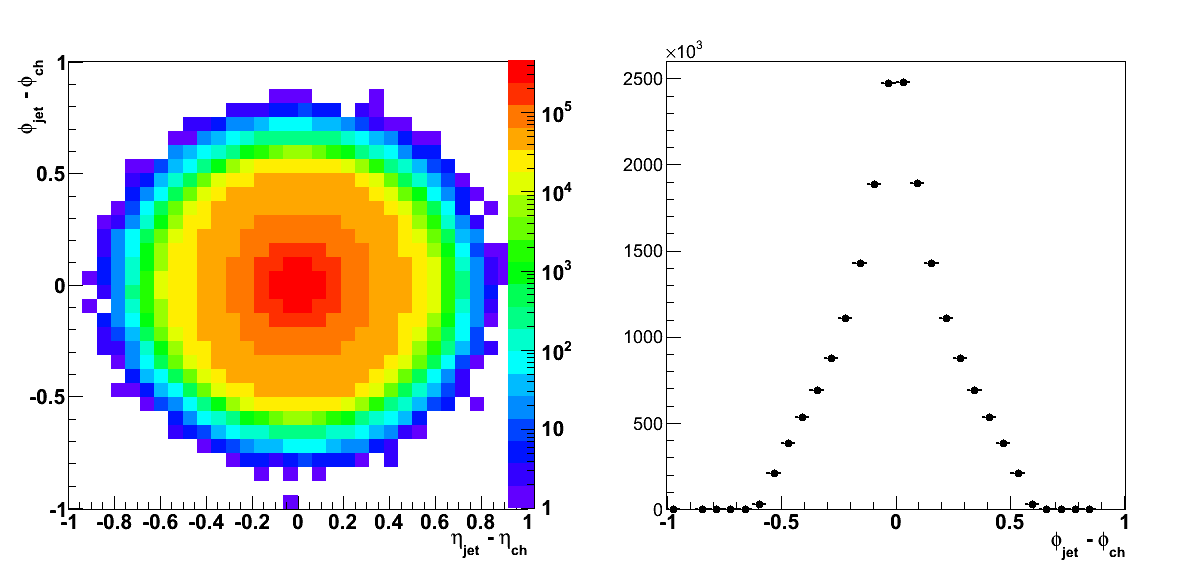
Finally, I have calculated asymmetries in jT for two ranges of z: 0.1 < z < 0.8 and 0.4 < z < 0.8. Smaller z gets bogged down by stuff at the low end of the fragmentation chain, while higher z gets close to exclusive production and heavy trigger bias.
Figure 3
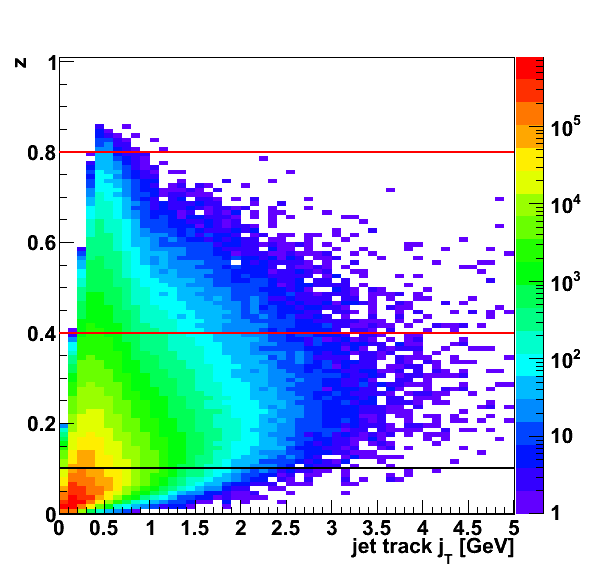
Run-11 triggers push the jT reach much lower than Run-6, and I don't have many events at higher jT. I will evaluate Collins asymmetries in jT for two ranges of z: 0.1 < z 0.8 and 0.4 < z < 0.8 as denoted by the horizontal lines.
Figure 4
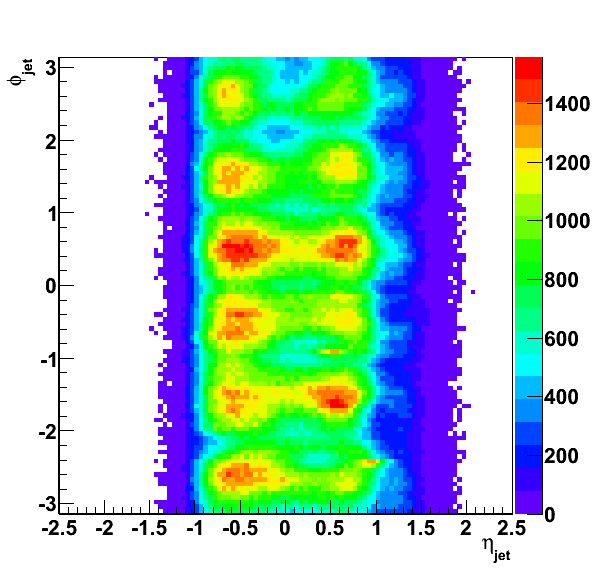
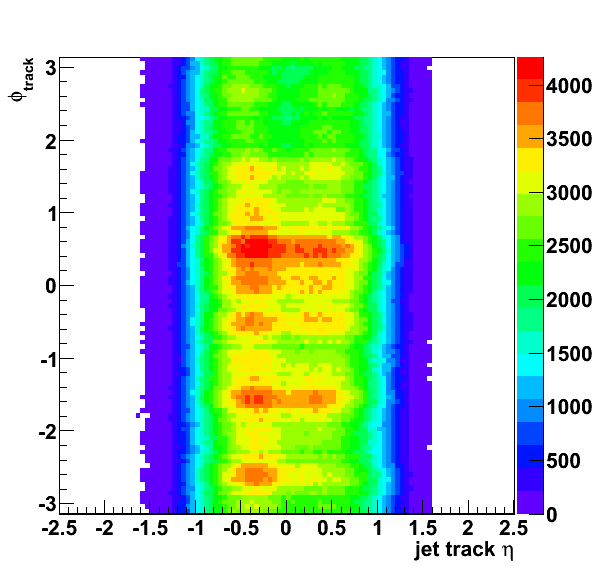
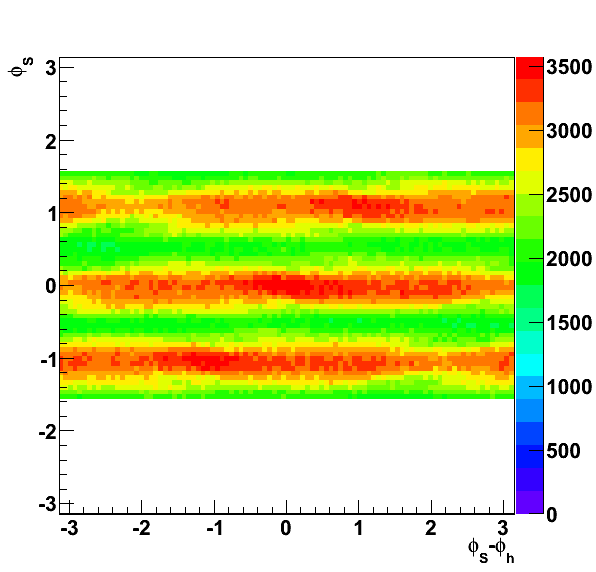
Asymmetries
Asymmetries, again, are shown before correcting for polarization. Note the axis is labeled "Pbeam×AN."
Sivers Asymmetries
Figure 5: Sivers Asymmetry in Bins of ηjet
| All Triggers | JP0 | JP1 |
|---|---|---|
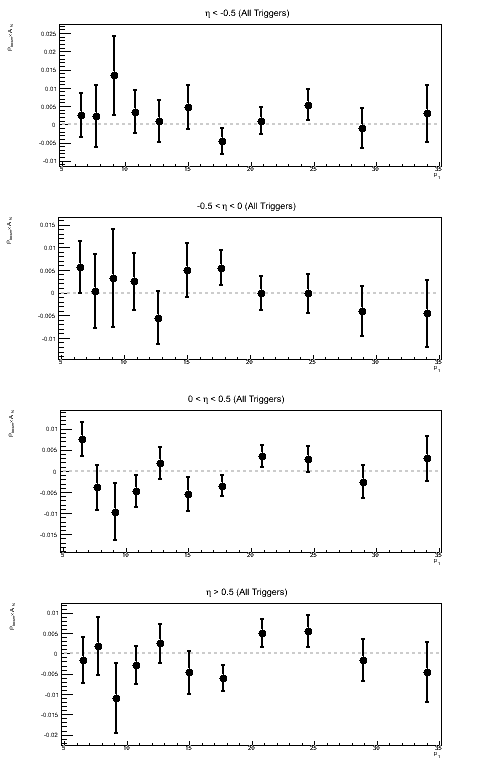 |
 |
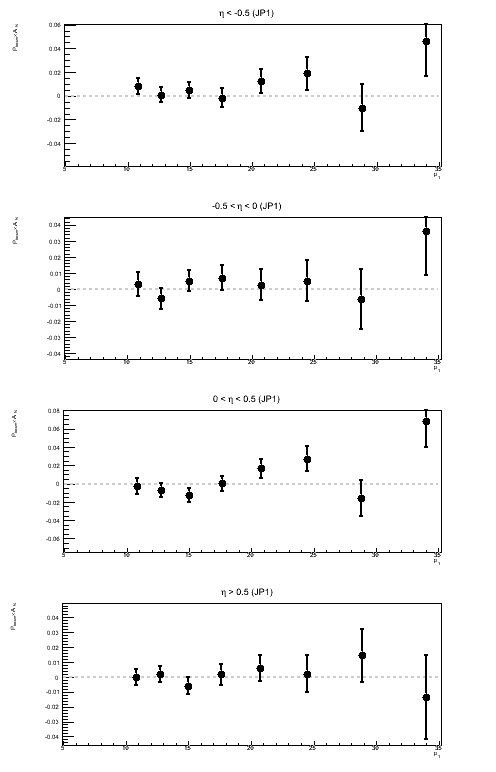 |
| JP2 | AJP | VPDMB |
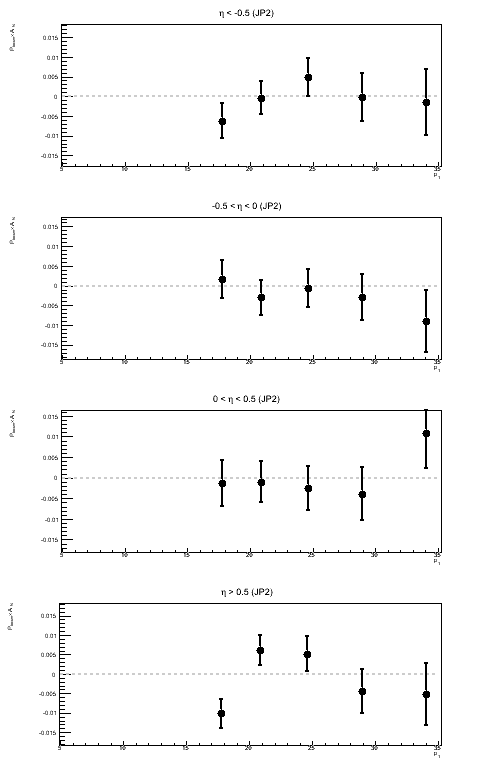 |
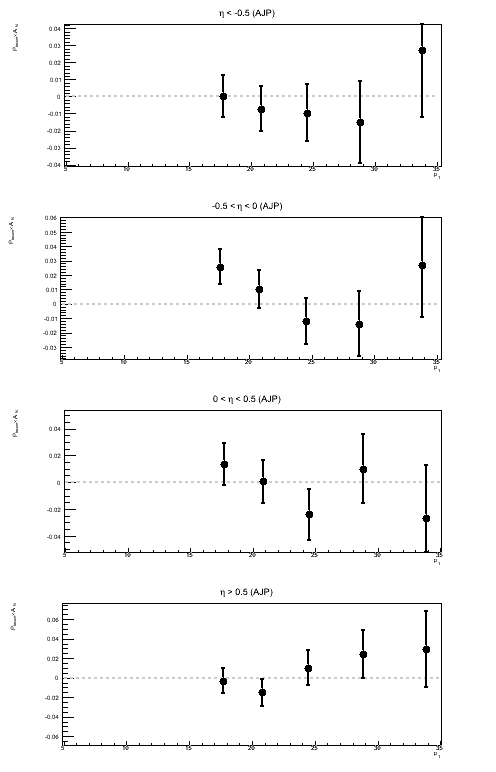 |
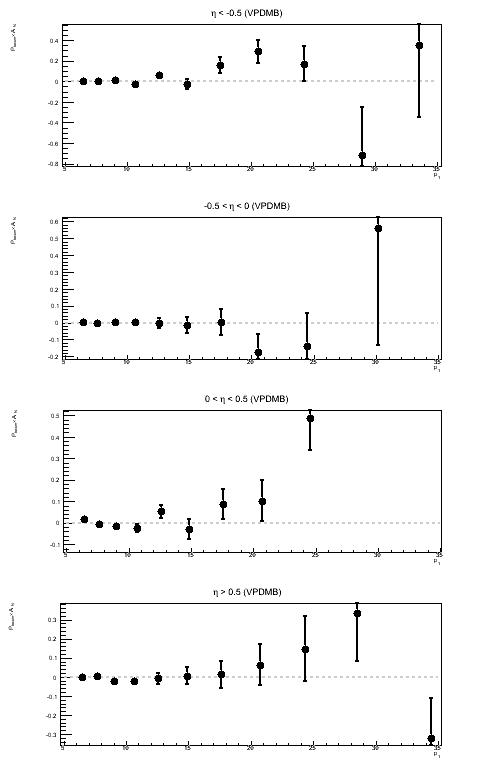 |
Above, I show the Sivers asymmetry as a function of jet pT for different bins of ηjet. Naïvely, I would assume a real Sivers effect would increase as one moves forward in η and exhibit something like a 1/pT-dependence. I do not see anything resembling a 1/pT-dependence. I am also wary of concluding anything from JP1 and VPDM at rather high pT. As a follow-up to this, it is worth looking at the actual sin(φS) fits to see if the fit itself is believable.
Collins Asymmetries
To bin for the Collins asymmetries my code includes the following for z and jT bins:
const double zbins[nzbins+1] = { 0., 0.05, 0.1, 0.2, 0.3, 0.4, 0.5, 0.8, 1. };
const double jtbins[njtbins+1] = { 0., 0.1, 0.2, 0.3, 0.5, 0.7, 1., 2., 10. };
Figure 6: Collins Asymmetry as a Function of z
| Triggers | |
|---|---|
| charge > 0 | charge < 0 |
.png) |
.png) |
| Comparison of Hemispheres and xF | |
| charge > 0 | charge < 0 |
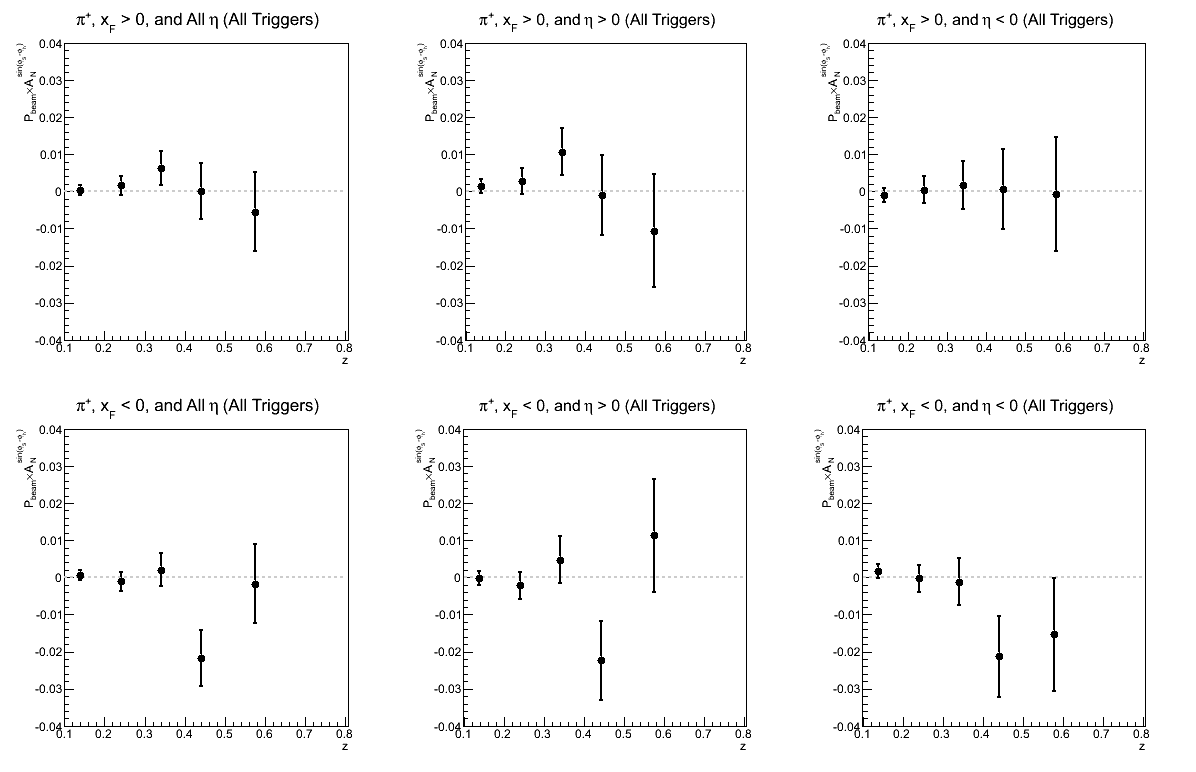 |
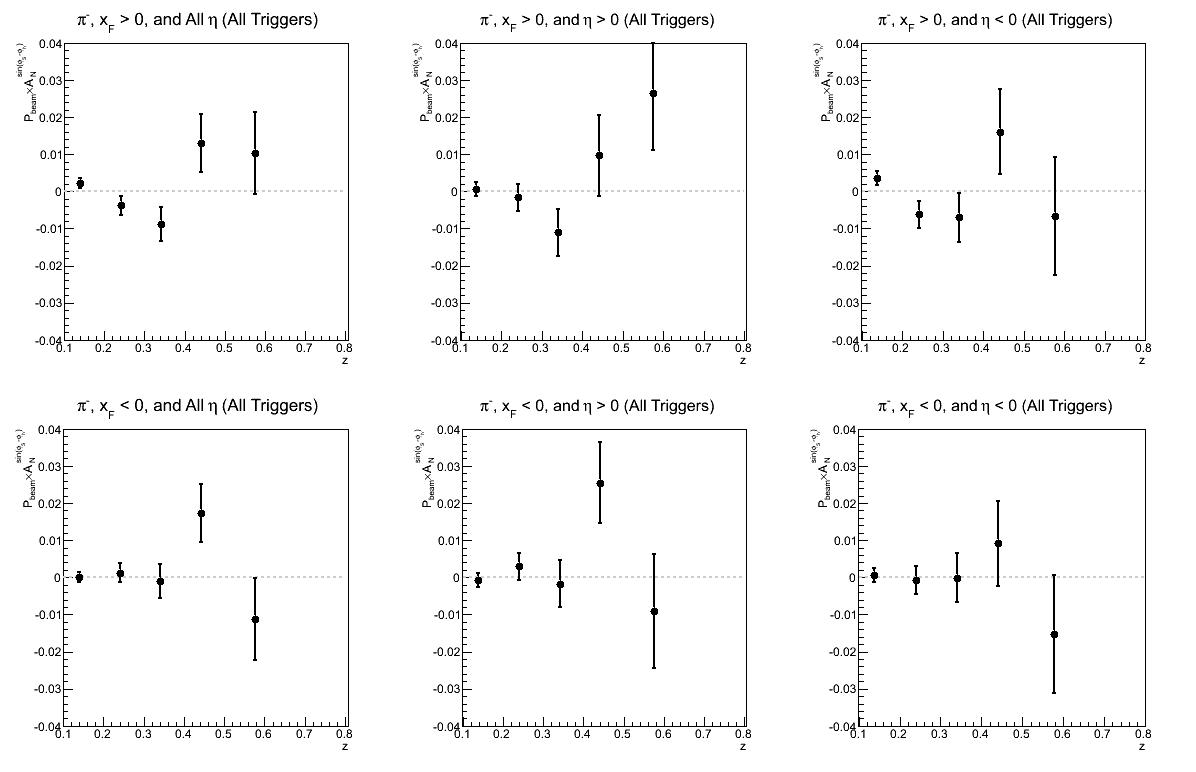 |
While not necessarily optimal for one's eyes, I have kept the vertical scales the same to try to give a sense of which triggers are contributing and where. There does seem to be a hint of charge-sign dependence to the asymmetries in z, but I will definitely need more statistics before daring to state conclusions so firmly.
Figure 7: Collins Asymmetry as a Function of jT (0.1 < z < 0.8)
| Triggers | |
|---|---|
| charge > 0 | charge < 0 |
.png) |
.png) |
| Comparison of Hemispheres and xF | |
| charge > 0 | charge < 0 |
.png) |
.png) |
Again, we see hints of charge-sign dependence; but more statistics are needed for sensitivity to what appears to be a rather small effect, if any.
Figure 8: Collins Asymmetry as a Function of jT (0.4 < z < 0.8)
| Triggers | |
|---|---|
| charge > 0 | charge < 0 |
|
|
.png) |
| Comparison of Hemispheres and xF | |
| charge > 0 | charge < 0 |
.png) |
.png) |
Again, I have so few statistics in the high-z region that it is difficult to draw conclusions.
Collins-like Asymmetries
I have also looked at the sin(φS-2φh) or "Collins-like" asymmetry. The bins are the same as for the Collins asymmetry.
Figure 9: Collins-like Asymmetry as a Function of z
| Triggers | |
|---|---|
| charge > 0 | charge < 0 |
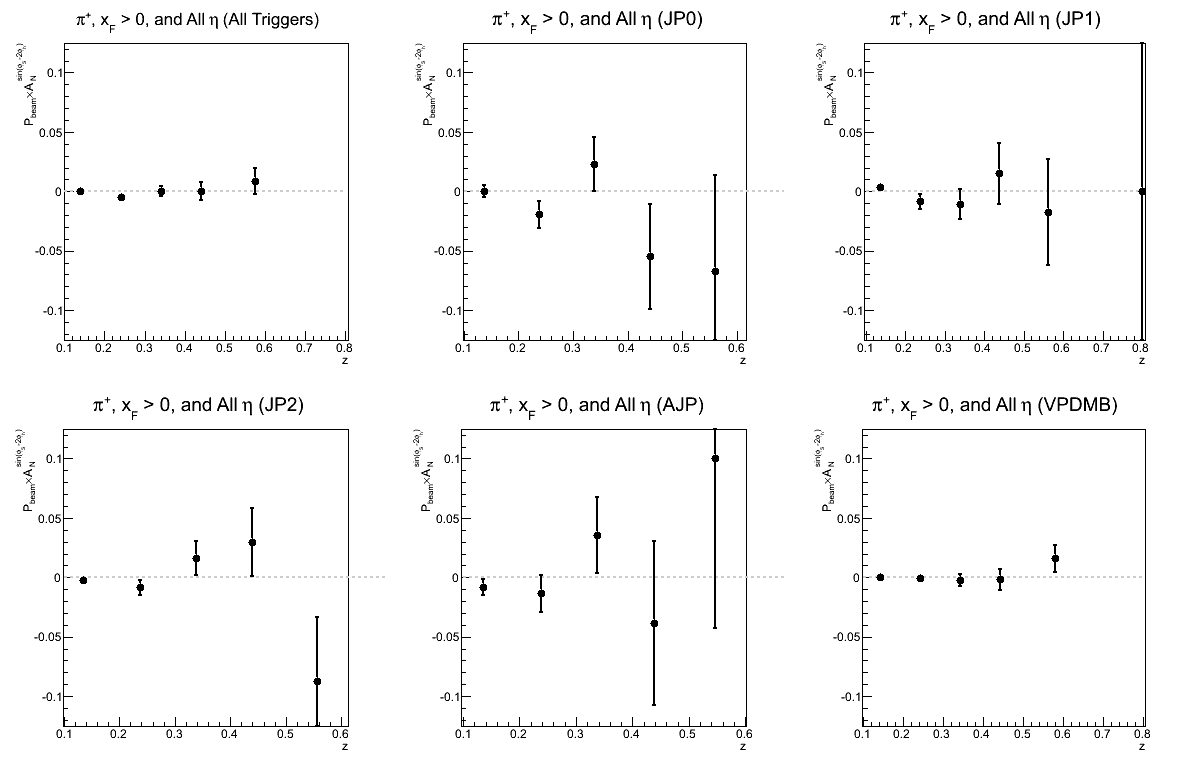 |
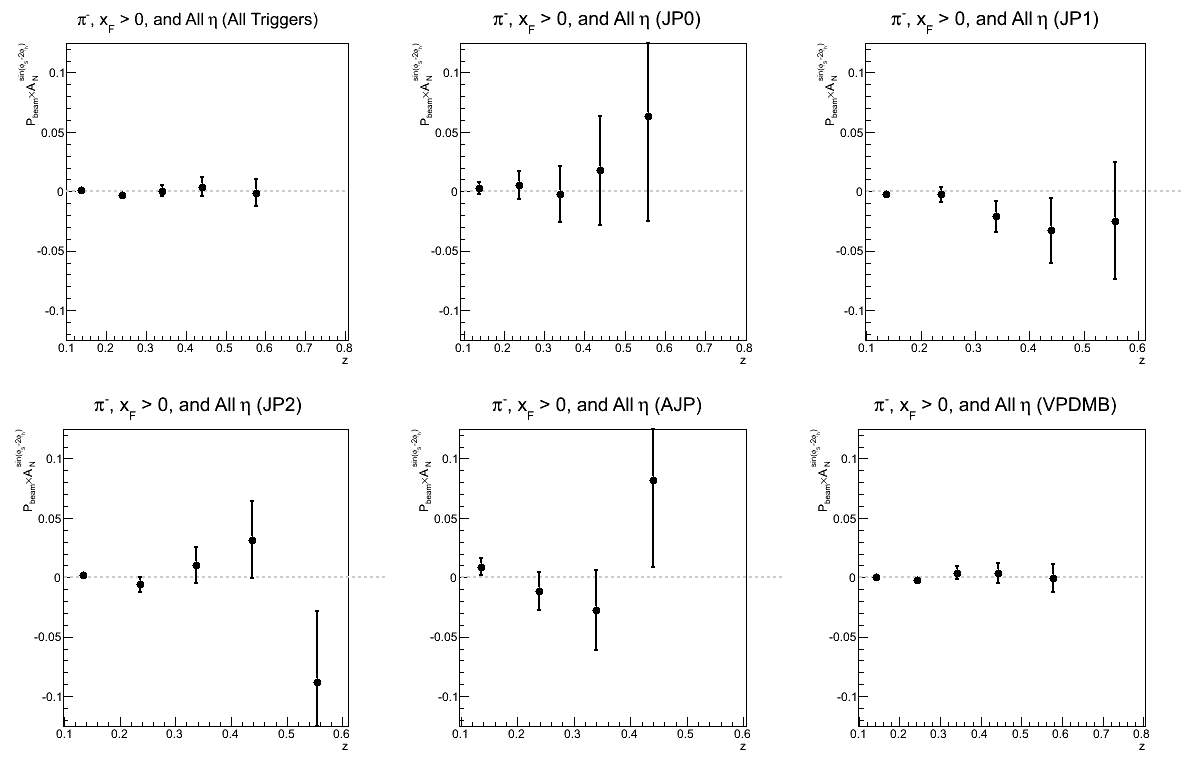 |
| Comparison of Hemispheres and xF | |
| charge > 0 | charge < 0 |
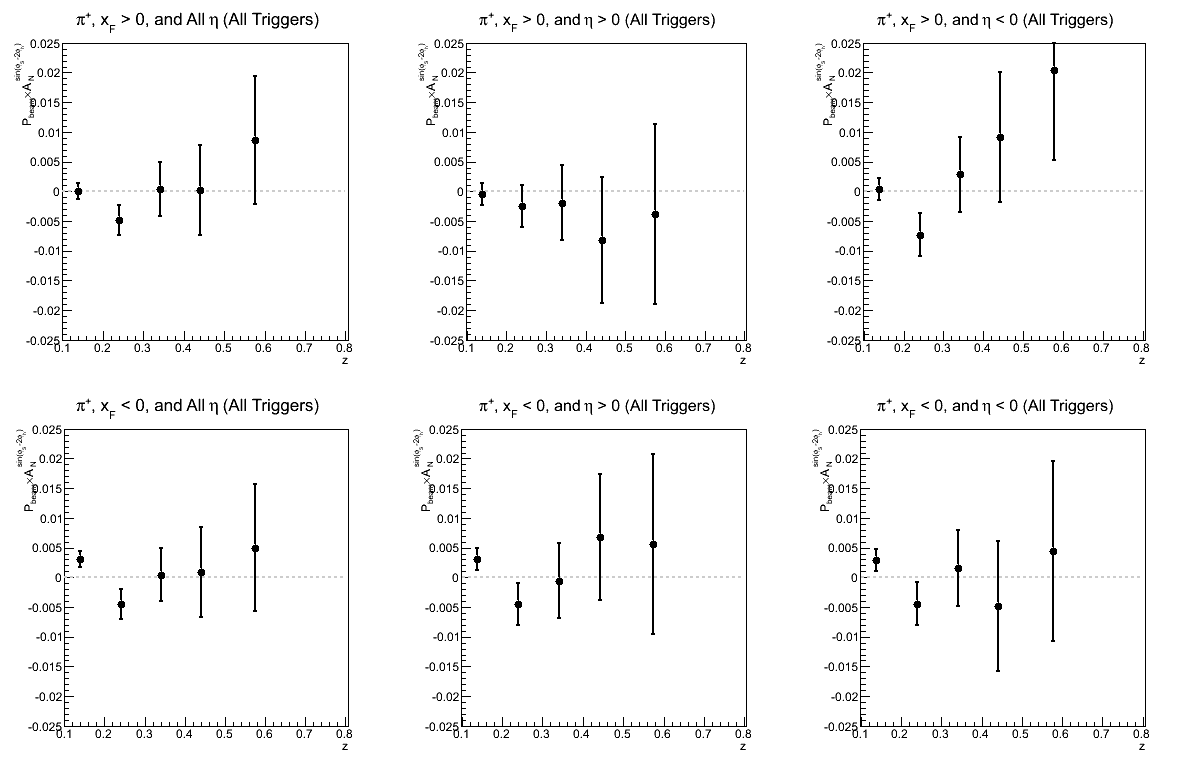 |
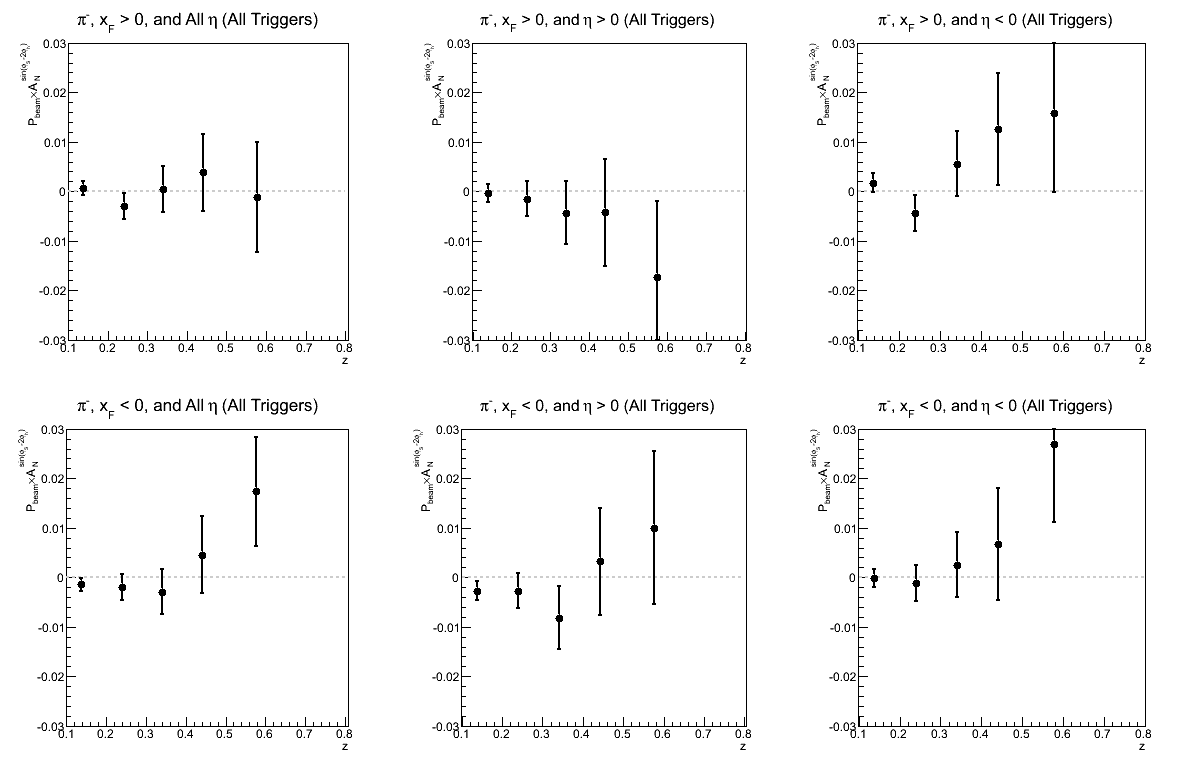 |
Figure 10: Collins-like Asymmetry as a Function of jT (0.1 < z < 0.8)
| Triggers | |
|---|---|
| charge > 0 | charge < 0 |
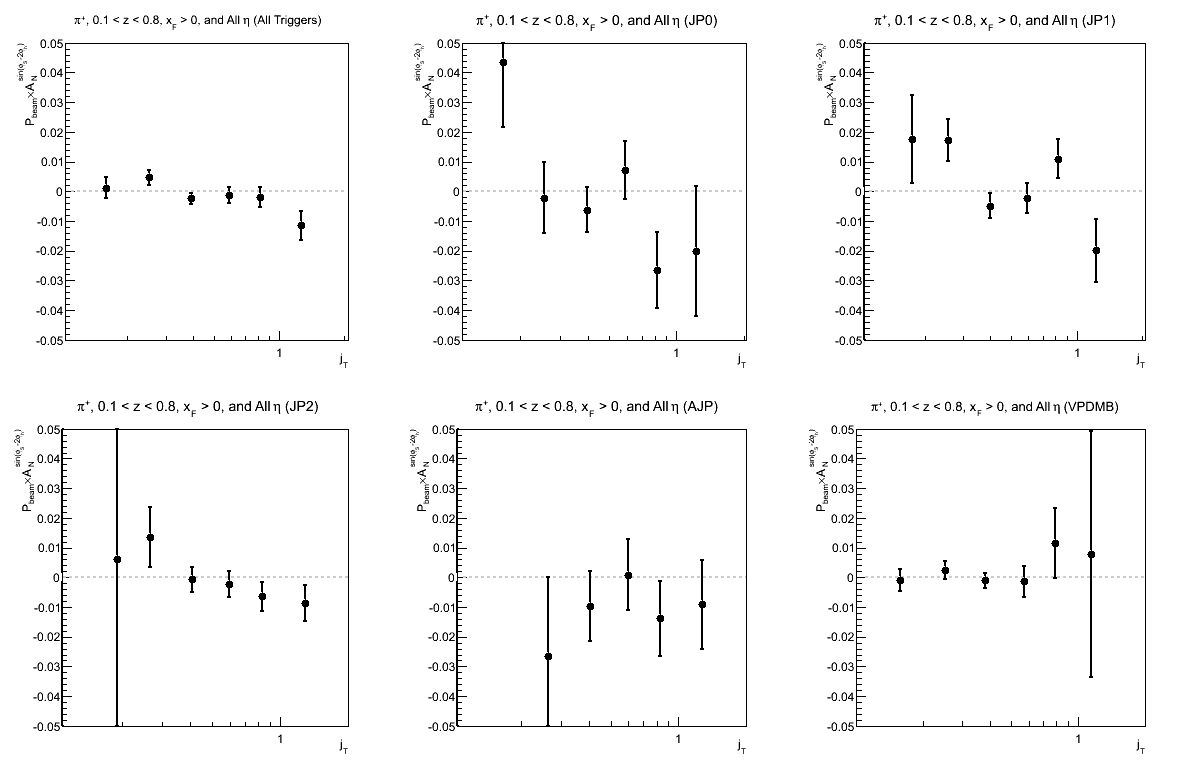 |
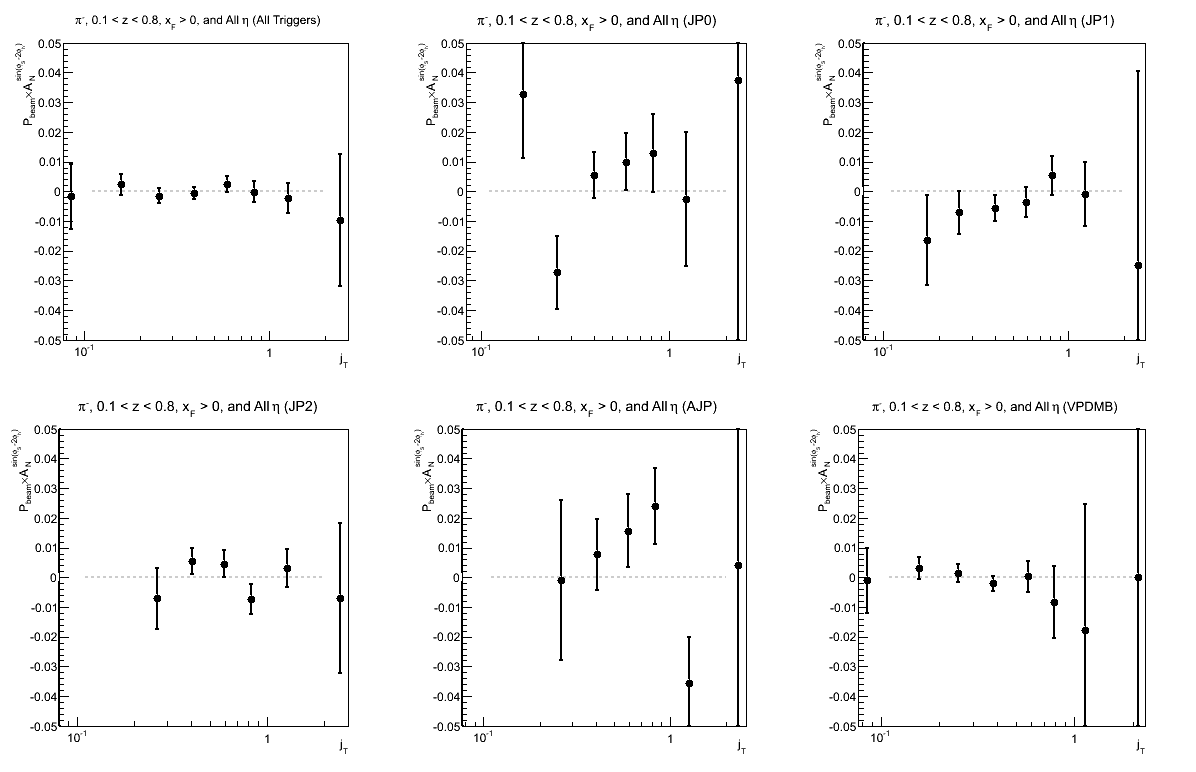 |
| Comparison of Hemispheres and xF | |
| charge > 0 | charge < 0 |
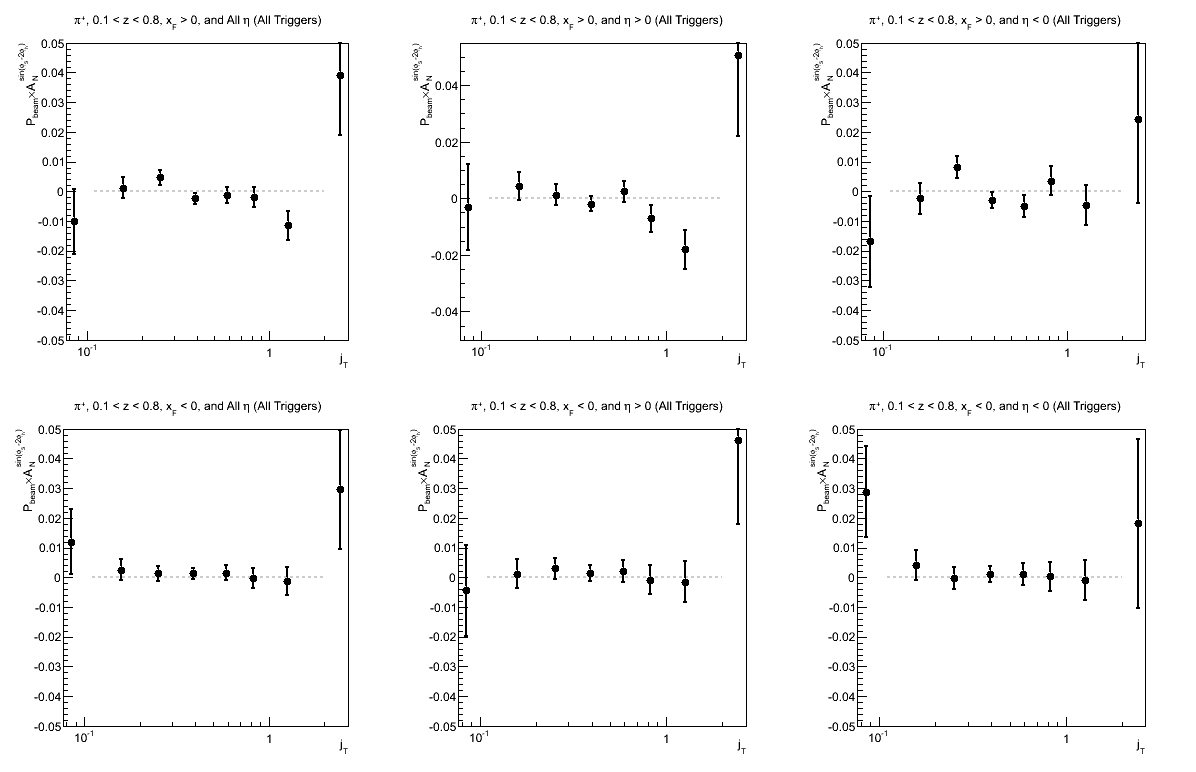 |
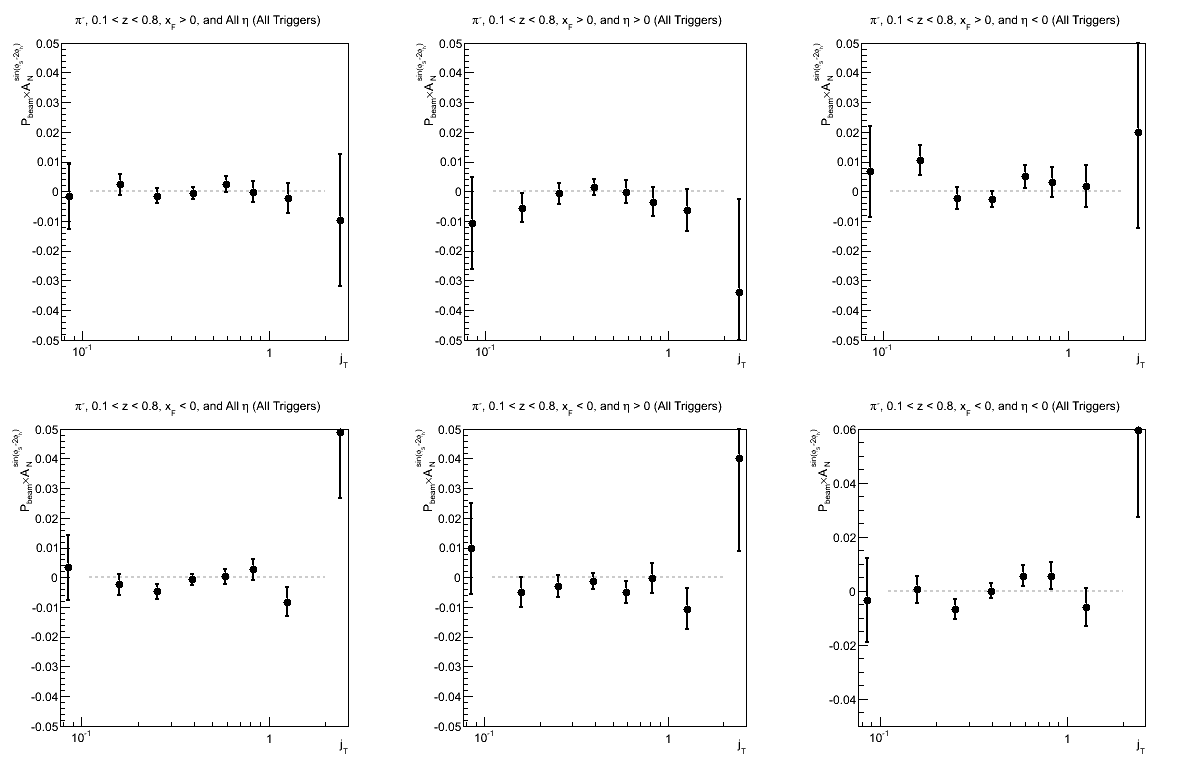 |
Figure 11: Collins-like Asymmetry as a Function of jT (0.4 < z < 0.8)
| Triggers | |
|---|---|
| charge > 0 | charge < 0 |
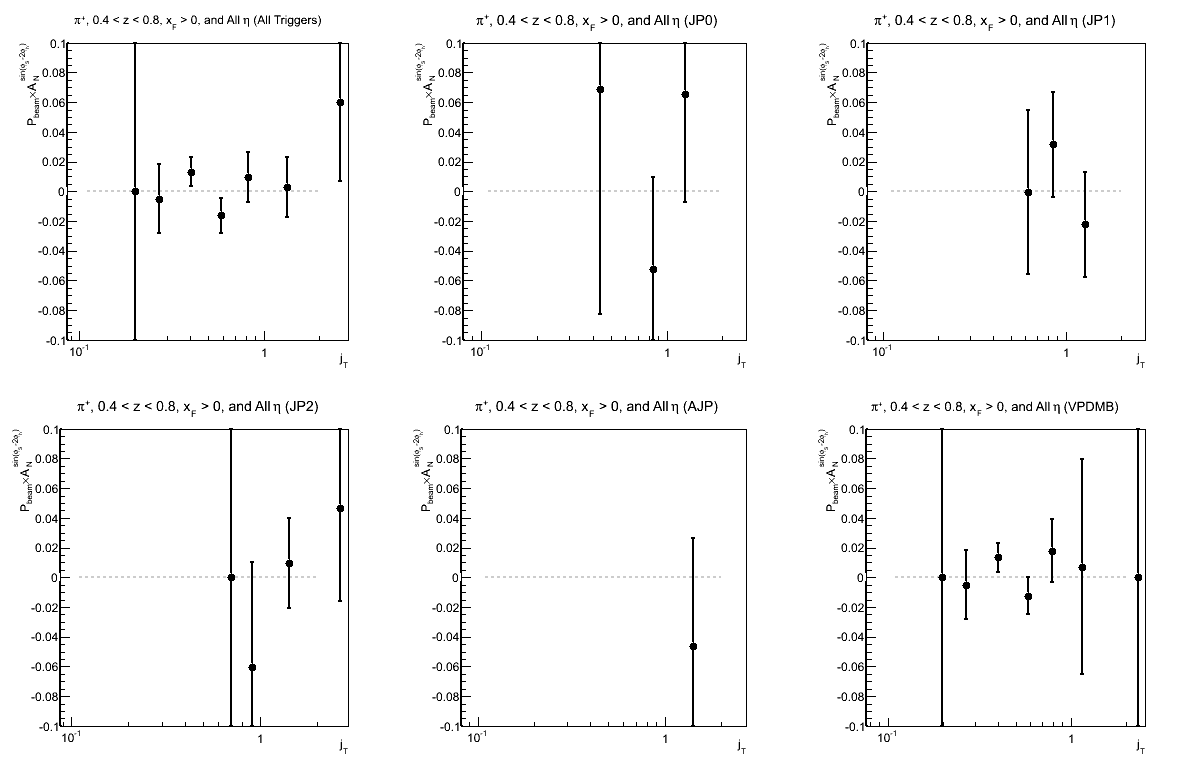 |
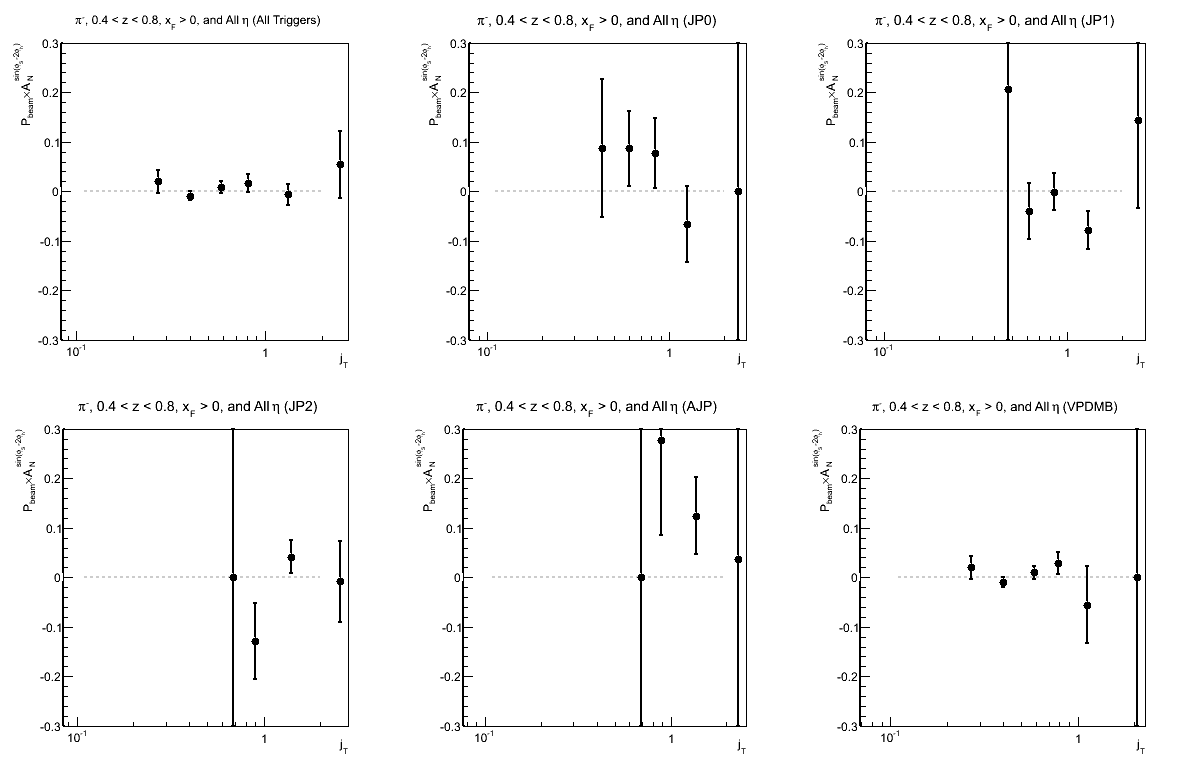 |
| Comparison of Hemispheres and xF | |
| charge > 0 | charge < 0 |
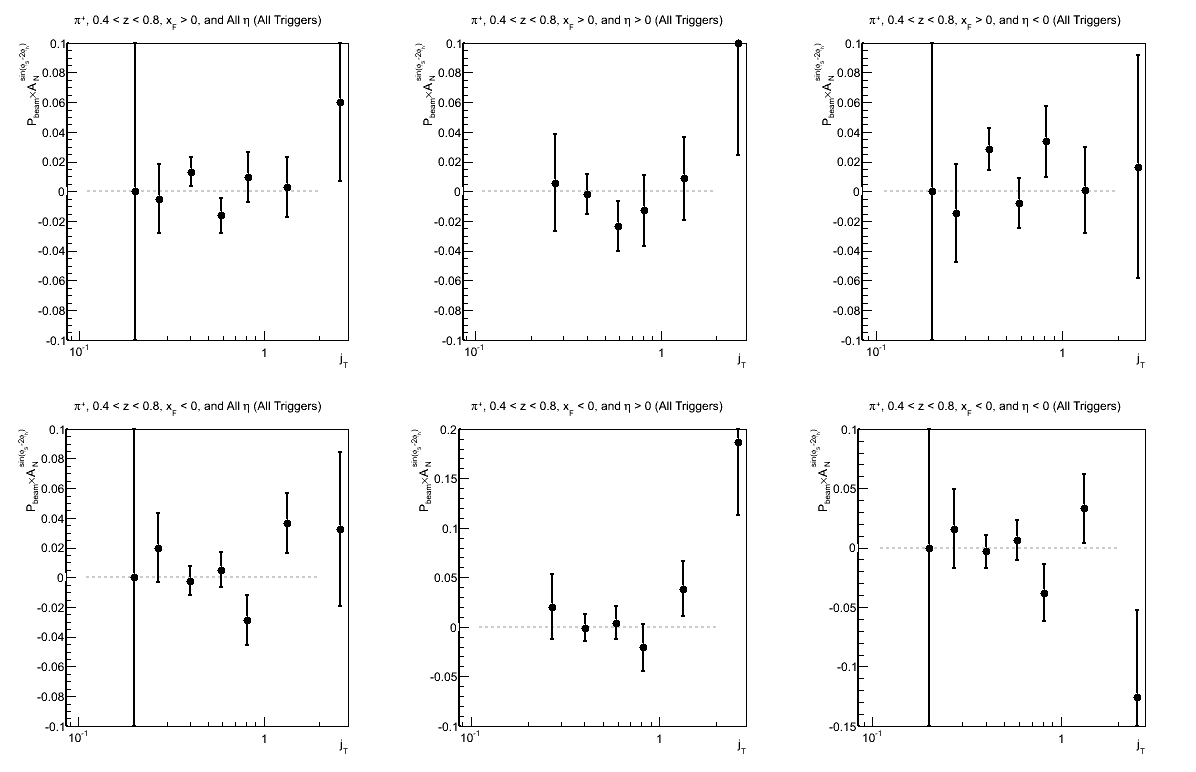 |
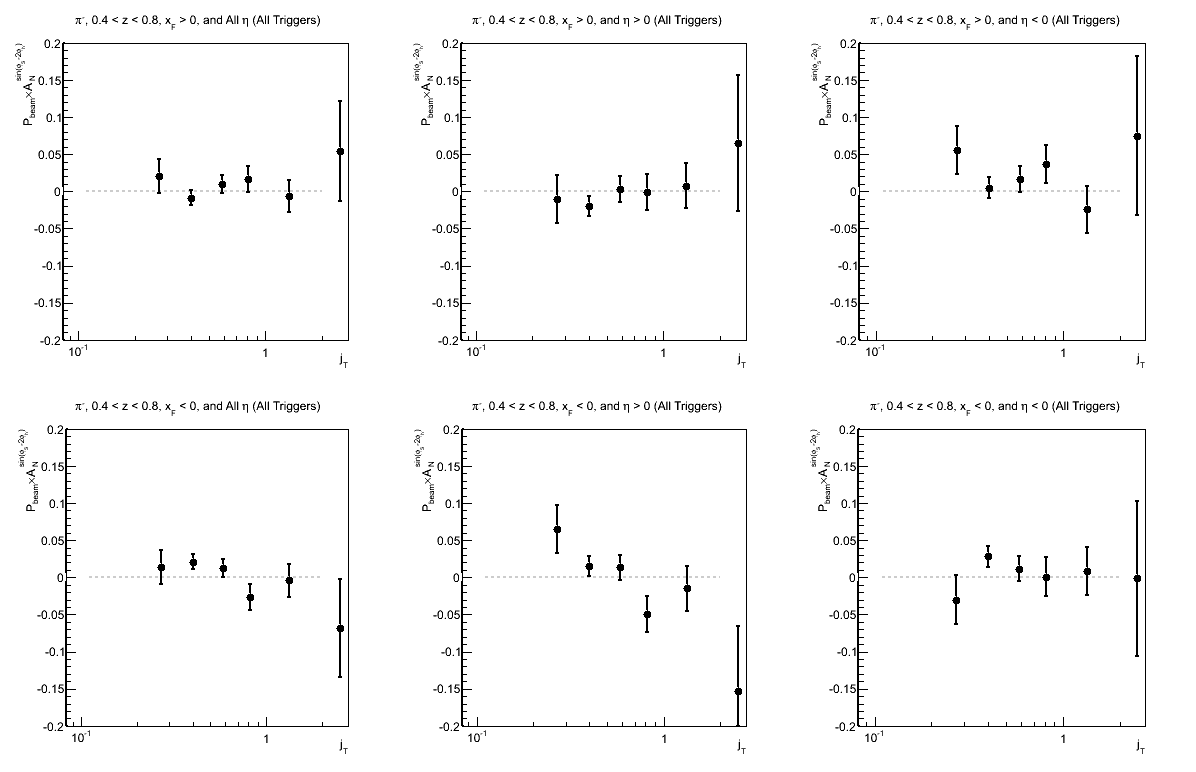 |
Statistical Cross-checks
p0 From Fits
In principle, the p0's from my fits should be the same. Thus, a good cross-check is to see if the p0's are consistent within statistical uncertainties.
Figure 12: p0 for Sivers Asymmetry as a Function of pT
| Triggers |
|---|
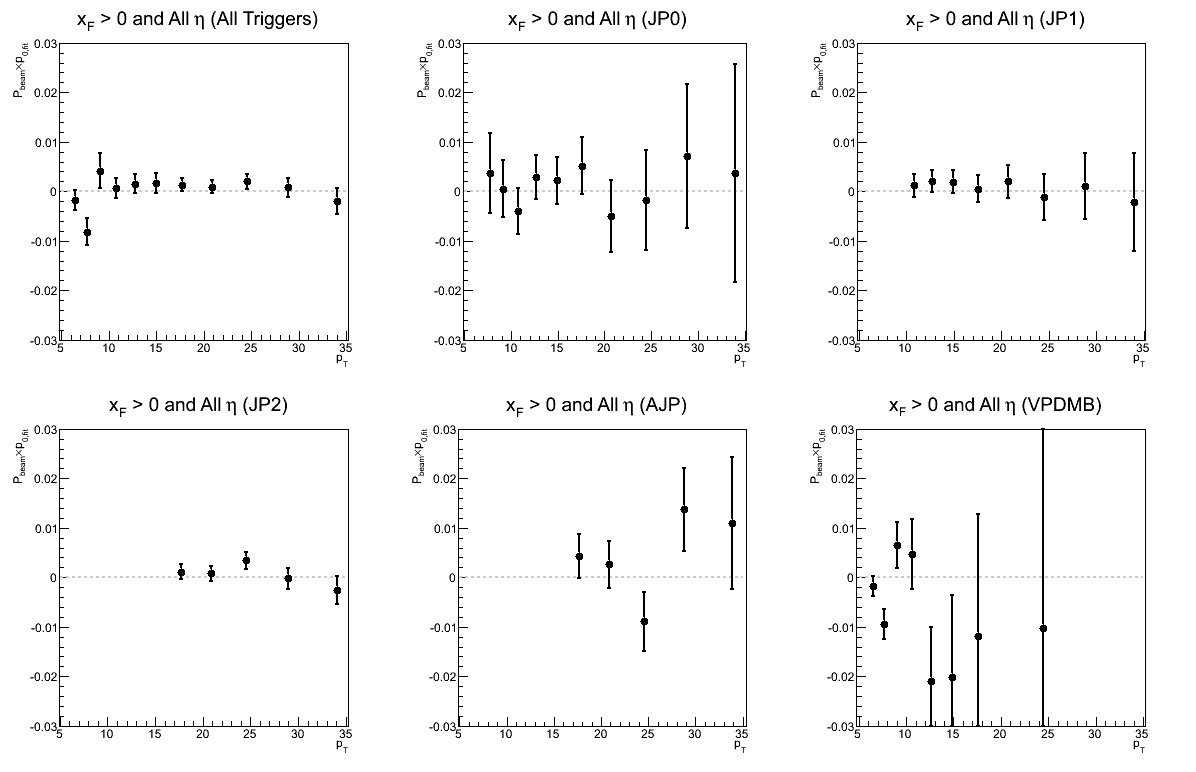 |
Figure 13: p0 for Collins Asymmetry as a Function of z
| Triggers | |
|---|---|
| charge > 0 | charge < 0 |
 |
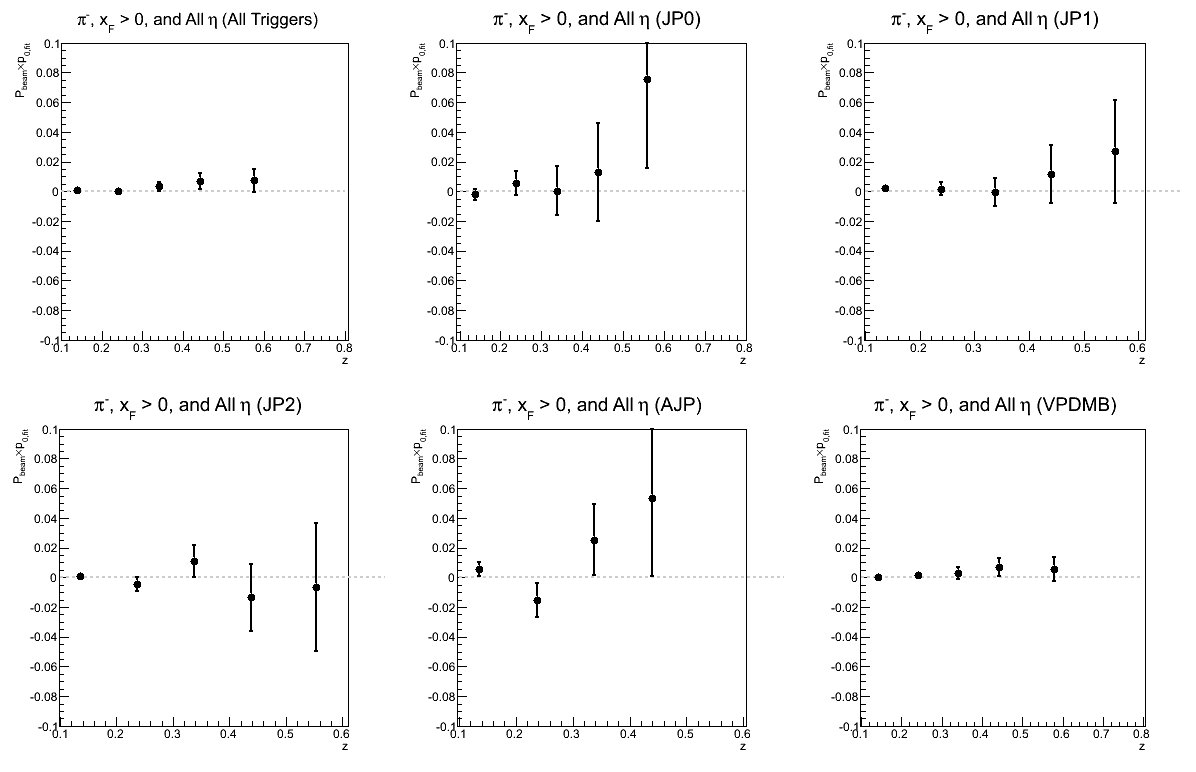 |
Figure 14: p0 for Collins Asymmetry as a Function of jT
| Triggers | |
|---|---|
| charge > 0 | charge < 0 |
.png) |
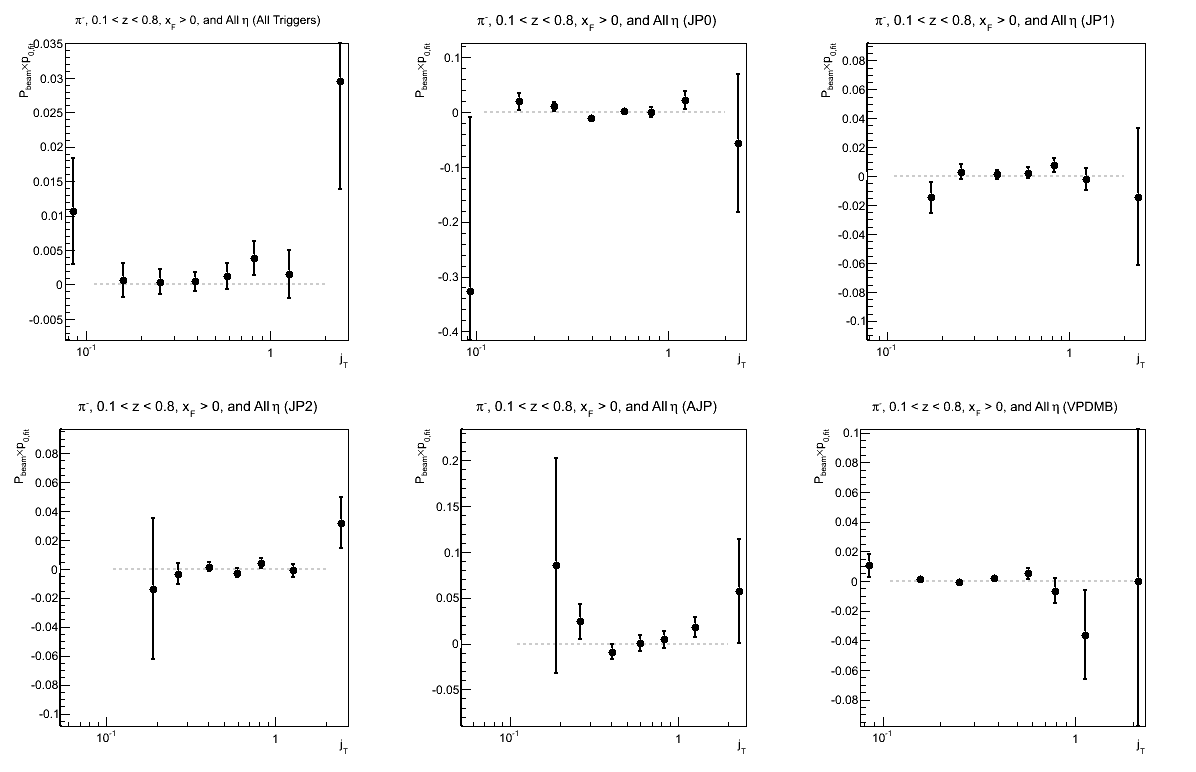 |
Figure 15: p0 for Collins-like Asymmetry as a Function of z
| Triggers | |
|---|---|
| charge > 0 | charge < 0 |
 |
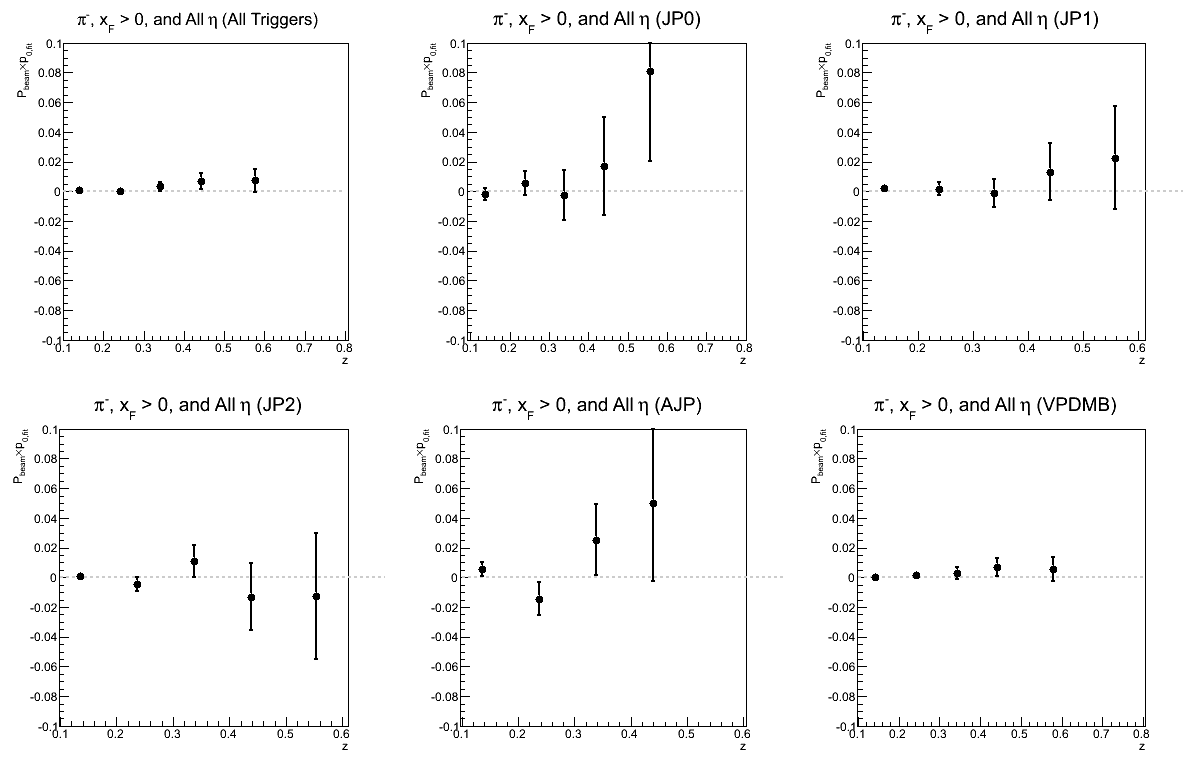 |
Figure 16: p0 for Collins-like Asymmetry as a Function of jT
| Triggers | |
|---|---|
| charge > 0 | charge < 0 |
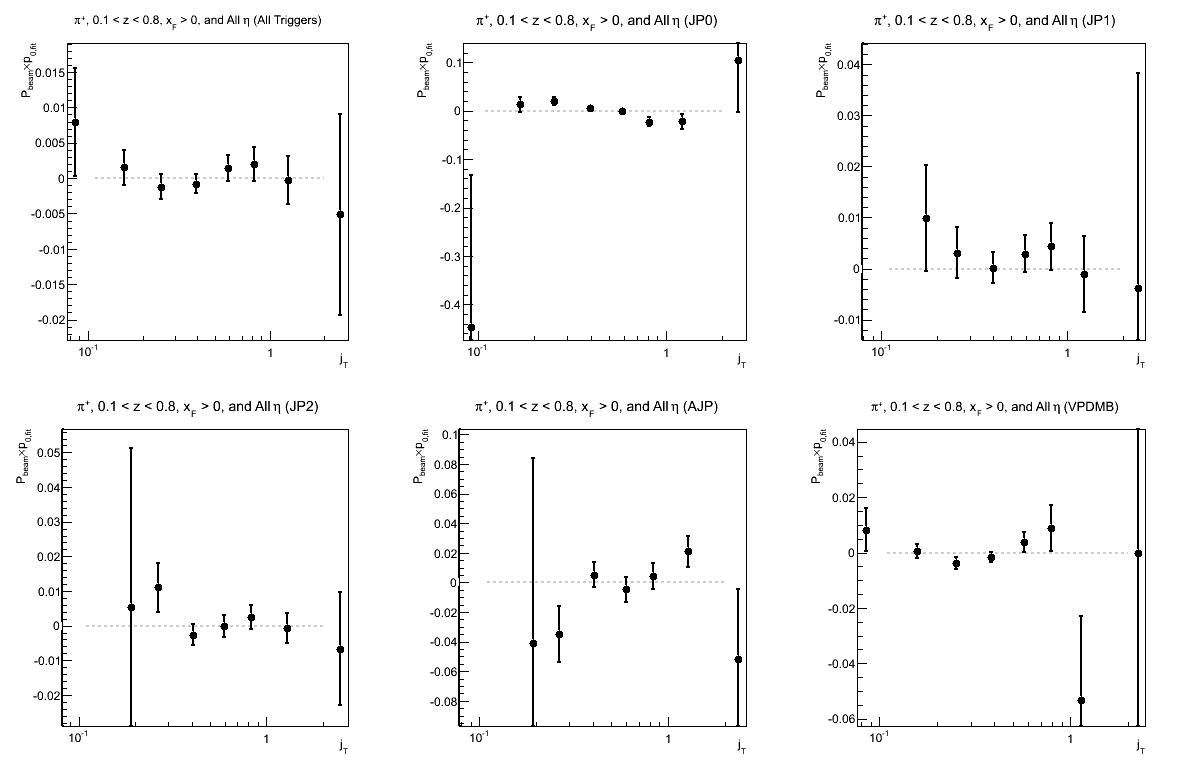 |
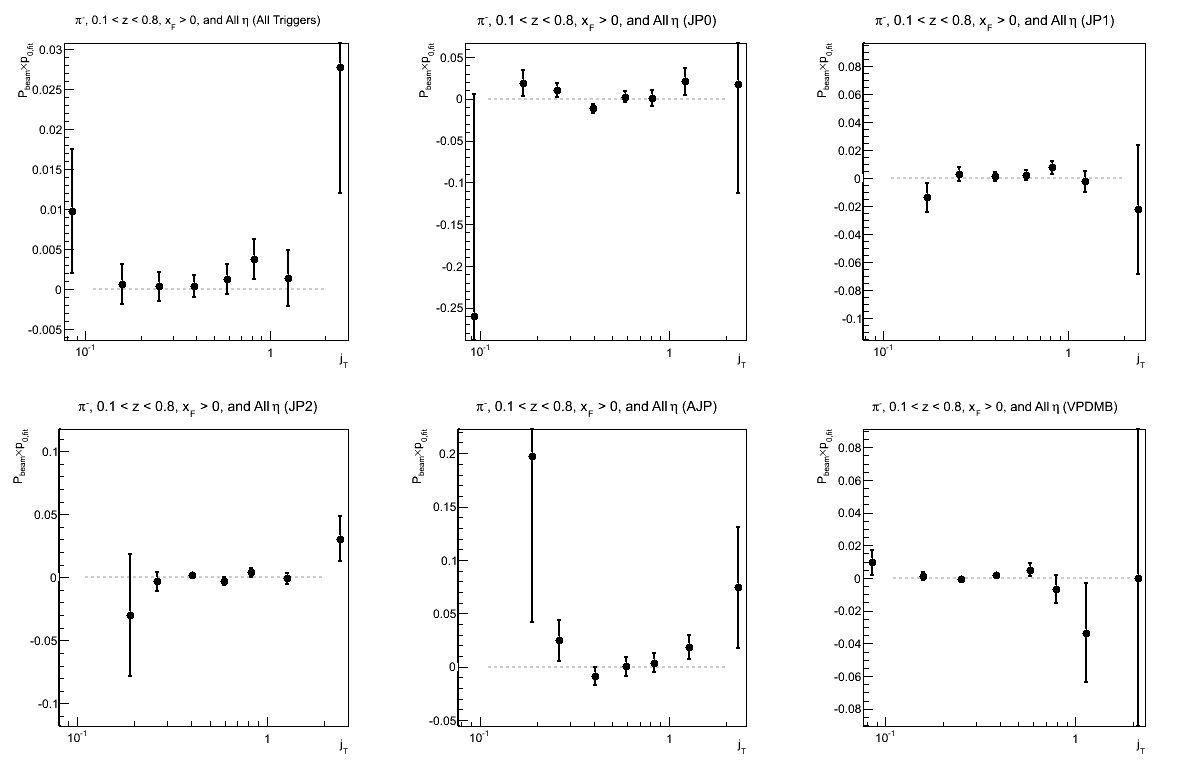 |
An additional useful test is to examine the χ2 distribution of the fits. Carl has suggested this, and I intend to do it. I will post the figures when I have them ready.
- drach09's blog
- Login or register to post comments

